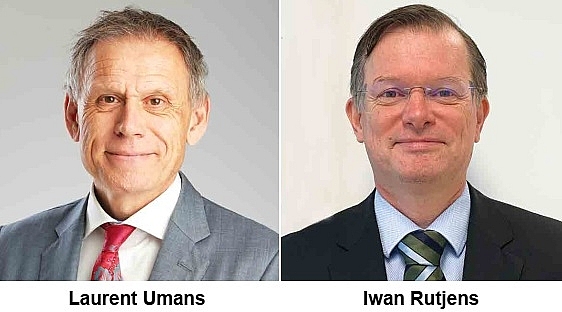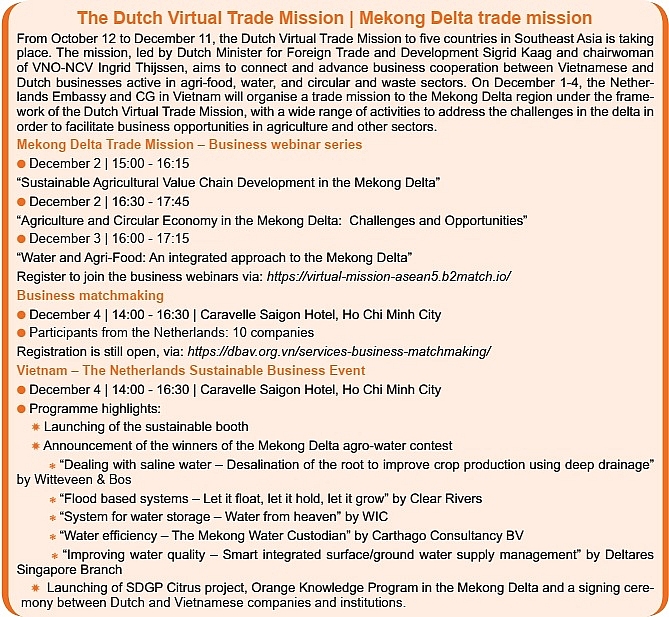Connecting the dots for sustainability
 |
Both Vietnam and the Netherlands have embarked on a sustainable development pathway that requires a deeper integration of people, profit, and planet. In our recovery we have to ‘build back better’ and that will require a more comprehensive and integrated approach of economy and ecology in our economic growth models. Substantial investments are needed from both the government and the private sector. Last year, Vietnam and the Netherlands signed a comprehensive partnership agreement. This challenge provides an excellent opportunity for a comprehensive and integrated Dutch-Vietnamese approach.
An example of an integrated approach is the way the Netherlands innovated its spatial planning. In the highly populated and flood-prone Dutch river delta each plot of land is valuable, has multiple interested parties and can be used in multiple ways. Then came climate change, which prompted the Dutch in the early 2000s to invest substantially in adapting water infrastructure and delta management in order to move from vulnerability to resilience.
Rather than continuing to heighten the dykes, Dutch planners gave ‘room’ to the river to flood uninhabited areas. Rather than losing beaches due to erosion, dredging companies were supplying sand to the shores. This inspired also the government of Vietnam to take action and to reshape the Mekong Delta landscape, thereby giving a boost to the Vietnam-Netherlands partnership.
The Netherlands and Vietnam started their cooperation in the Mekong Delta in 2010. It has become clear that in the Mekong Delta the changing climate causes changing water conditions like sea level rise and erratic weather patterns. This is exacerbated by developments like upstream dam building and downstream dyke construction.
Groundwater extraction that accelerates land subsidence and sand mining further contribute to the changing water flows. It became also clear that there is an increase in areas where there is too much water, too little water or too salty water.
The agro-water nexus
In the Mekong Delta, climate change and changing water conditions have severe impact on agriculture. For example, the year-round freshwater zone to grow rice is shifting to higher elevations. The coastal zone becomes increasingly brackish, which is an opportunity for shrimp farming. But rice irrigation systems are not easily transformed into a landscape with healthy shrimp ponds.
This will depend on adjusting the water infrastructure. Another example is the salinity intrusion and drought that requires farmers in large parts of the Mekong Delta to adapt.
Thus, water and agriculture are interacting – they are two interlinked parts of the same delta system. This is called the agro-water nexus. This nexus stresses the importance of an integrated approach to governance and to business. Regarding governance, the implications of the nexus approach requires a shift from separating institutional mandates to connecting institutional plans and investments. With the drafting of the Mekong Delta Regional Masterplan by Royal Haskoning DHV and the Ministry of Planning and Investment, an important step is set towards an integrated approach.
Connecting the business
It is key for the agro-business community to understand what impact water might have on agriculture and vice versa. This helps to assess business risks but also business opportunities. For instance, in the Mekong Delta, seed companies are working on salt and drought tolerant crops. The business risks of farmers turn into business opportunities for input suppliers who then provide new solutions.
Increasingly, governments and businesses need to work together on the challenges of spatial planning, delta management and climate adaptation. The government’s budget is not enough to bear all the costs of water infrastructure and the rate of return on these projects is often not enough to incentivise the private sector to step in – so there is a need to stitch together both public expenditure and private investment. The new Law on Public-Private Partnership Investment in Vietnam sets out the rules of the game for this.
Closing the circle
The droughts in 2019 and 2020 also triggered technical solutions for circularity and smart water use.
Where water is too scarce to circulate, Dutch consultants from Deltares and Delft University are designing systems to store water during the wet season in the sandy dunes of the Mekong Delta.
At the start of the dry season, this water is pumped up and used to prolong the agricultural production. In the next wet season water is infiltrated again. This cycle is sustainable as long as water quality is good. It allows farmers to grow an extra crop without overexploiting.
 |
Making more connections
The agro-water nexus is a showcase for the integrated approach but it is not the only case. Another step is to connect the logistical sector into this approach. The Dutch-Vietnamese Waterborne partnership consisting of Royal Haskoning BV, STC International, Marin, Port of Rotterdam, Deltares, Noordersoft, Smart Atlantis, Solveigh Corporate Development BV, and CDR International is working on multi-model inland waterway transportation. This is in close partnership with Vietnam Inland Waterway Authority, Vietnam University of Transport Technology, and the Vietnam Maritime University.
This improves not only port and waterway infrastructure but also connectivity, safety, and environmental standards between transport over water, on the roads and in the air. For instance, Marin proposed a new inland ship design according to Dutch best practices. This will enable better access to the EU market for all products from the Mekong Delta and other parts of Vietnam.
The future for the comprehensive partnership between Vietnam and the Netherlands is bright and promising. The challenges of today force us to connect public and private, economy and ecology, and to co-create an integrated approach by connecting the dots. It means collaboration among people, institutions, and companies that can have vastly different interests, roles and cultures.
It will not be easy, but the rewards are big: resilience, sustainability, and profitability. This is the cornerstone of the Vietnamese-Netherlands Comprehensive Partnership.
What the stars mean:
★ Poor ★ ★ Promising ★★★ Good ★★★★ Very good ★★★★★ Exceptional
Themes: Climate Change Response
Related Contents
Latest News
More News
- VAL inaugurates second production line to meet domestic animal feed demand (December 19, 2025 | 16:37)
- Sun Group pioneers urban tram system in Phu Quoc (December 19, 2025 | 15:00)
- Top 10 notable events of Vietnam’s industry and trade sector in 2025 (December 19, 2025 | 14:00)
- Seven major projects launched to drive Hanoi’s next growth phase (December 19, 2025 | 14:00)
- Rare, beautiful, sustainable: the mark of iconic real estate (December 19, 2025 | 08:00)
- Mondelez Kinh Do - a chapter of purpose-led leadership in Vietnam (December 18, 2025 | 09:44)
- VNPAY services receive the highest-level PCI DSS international security certificates for six consecutive years (December 17, 2025 | 23:47)
- F&N deepens investment in Vinamilk (December 17, 2025 | 09:00)
- Long-term capital seen as key hurdle to green growth (December 16, 2025 | 08:00)
- HDS Summit spotlights Vietnam’s rising role in regional supply chains (December 16, 2025 | 08:00)

 Tag:
Tag:





















 Mobile Version
Mobile Version